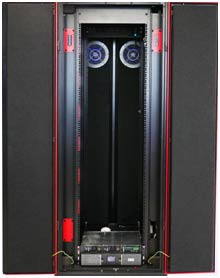
R&M: Time to Plan Infrastructures for the Edge of the Cloud
R&M based in Wetzikon, Switzerland, is advocating an extended and differentiated view of cloud computing. The growth in private and business data traffic continues unabated. And the Internet of Things, 5G and mobility also need to be taken into consideration. They are causing additional exponential growth of IP traffic and require ultra-lowlatency even in remote places. We don’t expect the hyperscale data centers that are coming into existence today to be able to fully cover network, computing and storage requirements in a few years. This is why new computing power at the edge of the network will have to extend and support the large, central data centers. For R&M, a natural consequence of data growth.
Providers and network operators, cities and utilities, industry, the media and transport companies can set up the necessary infrastructures for the periphery in good time providing they start doing so now. R&M sees a wide-scale increase in FO cabling and the installation of decentral micro data centers as being part and parcel of the necessary infrastructure. R&M describes micro data centers as an “autonomous, automatable and sturdy solution which has to be powerful enough to assume a leading role in the cloud.” R&M presented a visionary, fully automated model at Data Centre World 2018 in London.
The entire highway becomes a data center
A striking application example for edge computing is future road traffic. The scenario is based on information from the German Fraunhofer research institute. For cars to be fully automated and safe, they would have to be able to react within 0.1 milliseconds. The exchange of information with the environment, with antennas, sensors and other vehicles would effectively have to take place at the speed of light. Along with the future 5G services, that requires an FO network along the roadside. There would have to be servers or micro data centers on the roads or at base stations every 15 kilometers to guarantee virtually latency free interaction and process the most important data on site. Exchanging data using remote cloud data centers would be too slow to control traffic and ensure there were no accidents with the typical 1 to 2 milliseconds latency. The cloud could compile, analyze and store all traffic data that is not critical in terms of time in the background. But outside at the edge, there is zero tolerance for latency and a need for unconditional availability.
Hyperscale and edge are complementary
Alongside the trend toward edge computing, the hyperscale segment will continue to develop dynamically in the current financial year according to R&M observations. Edge computing and the central cloud infrastructures can only be developed together. They have to complement one another.
Digital business models such as virtualization and software defined data centers require immense, adaptable computing resources in the cloud, storage capacities and high transmission speeds. These market requirements can be served long term, flexibly, innovatively and in a failsafe manner with the hyperscale data center concept. Hyperscale data centers are currently mainly occurring at strategically important places and Internet modes or at places with an inexpensive energy supply.
The concept is based on hyperconvergence as well as on greatly and freely scalable, high density architectures. There has to be a mass of optical fibers and connectivity from the beginning to avoid bottlenecks. High-count fiber cables with more than 4,000 fibers are typically needed to cover the connectivity requirement. With the Building Entrance Facility BEF-60, launched in 2017, R&M has come up with an innovation for this task. Capacity-wise the cabinet offers 23,040 splices over 60 drawers. The BEF-60 serves as an entry point for hyperscale data centers with scalable spine and leaf topologies.
With the Ultra High Density platform Netscale, R&M is also setting a standard for the density of fiber optic ports within data centers. With up to 120 ports per height unit in the 19’’ rack, this patch panel achieves the highest density of all familiar products. Modular switches with a high port density are important components for creating cloud infrastructures in hyperscale data centers. R&M has developed the Netscale Blade Cabling Manager (BCM) for the efficient and correct addressing of vertical and horizontal modular switches. It routes cables directly from the switch ports to the patch panel ports which are below, above or beside the switch. This means cable management can be done without in the cabinet.
Hyperscale data centers accommodate hundreds of thousands of fiberoptic connections in sensitive operating environments. These quantities can no longer be managed in a traditional way. They have to be monitored fully automatically to be able to guarantee operational reliability. One solution for this is the intelligent infrastructure management system R&MinteliPhy. It consists of sensor strips for monitoring connections, an appliance for the concentration and transfer of signals as well as the server with administration, monitoring and planning functions. R&MinteliPhy can be used for controlling and asset management, for the mapping of the digital twin of the infrastructure as well as for analyses, audits, 3D visualization, DCIM and the development of risk scenarios. So, it not only supports technical management, but also compliance and economy management.
